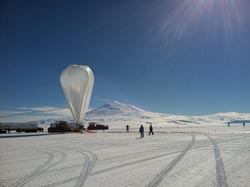NASA Super-Tiger Balloon Shatters Flight Record

<br>
The record-breaking balloon, carrying the Super Trans-Iron Galactic Element Recorder (Super-TIGER) experiment, has been afloat for 46 days and is on its third orbit around the South Pole.
“This is an outstanding achievement for NASA's Astrophysics balloon team,” said John Grunsfeld, associate administrator for the Science Mission Directorate at NASA Headquarters in Washington. “Keeping these huge balloons aloft for such long periods lets us do forefront science that would be difficult to do otherwise.”
Super-TIGER is flying a new instrument for measuring the rare heavy elements among the flux of high-energy cosmic rays bombarding the Earth from elsewhere in our Milky Way Galaxy. The information retrieved from this mission will be used to develop an understanding where these energetic atomic nuclei are produced and how they achieve their very high energies.
Super-TIGER launched Dec. 8, 2012, from the long duration balloon site near McMurdo Station, Antarctica. The massive 39-million cubic foot scientific balloon carries the 6,000 pound Super-TIGER payload — equivalent to a large sports utility vehicle — at a float altitude of 127,000 feet, more than four times the altitude of most commercial airliners. Size-wise, more than 200 blimps could fit inside the balloon.
The Super-TIGER flight shattered the previous record of 41 days and 22 hours, previously set in 2005. The Super-TIGER team plans to fly for another 8-10 days to have it fly closer to McMurdo Station before terminating the flight and recovering the experiment.
“It has taken eight years, but we are so excited about breaking the long duration balloon record. In addition, it looks like the Super-Tiger flight, which is still collecting science data, will raise the bar by a week or two,” said Debora Fairbrother, chief of the Scientific Balloon Program Office at NASA’s Wallops Flight Facility in Virginia.
The long duration balloon site at Willy Field, McMurdo Station, takes advantage of the stratospheric anti-cyclonic wind pattern circulating from east to west around the South Pole. The stratospheric wind circulation combined with the sparsely populated continent of Antarctica allows for long duration balloon flights at altitudes above 100,000 feet.
The National Science Foundation Office of Polar Programs manages the U.S. Antarctic Program and provides logistic support for all U.S. scientific operations in Antarctica. The NSF Antarctic Support Contractor provides material support to the NASA Balloon Program, including support of launch and recovery operations throughout the Antarctic Campaign.
The principal investigator of the Super-TIGER mission is Dr. Walter Binns of Washington University, St. Louis, Mo.
NASA’s Columbia Scientific Balloon Facility in Palestine, Texas, is responsible for launch operations and command and control of the balloon during flight.
To monitor the real time flight tracks of the long duration balloons on the Internet, visit:
http://www.csbf.nasa.gov/antarctica/ice.htm
For more information about NASA’s Balloon Program on the Internet, visit:
http://www.wff.nasa.gov/balloons
Media Contact
All latest news from the category: Physics and Astronomy
This area deals with the fundamental laws and building blocks of nature and how they interact, the properties and the behavior of matter, and research into space and time and their structures.
innovations-report provides in-depth reports and articles on subjects such as astrophysics, laser technologies, nuclear, quantum, particle and solid-state physics, nanotechnologies, planetary research and findings (Mars, Venus) and developments related to the Hubble Telescope.
Newest articles

Silicon Carbide Innovation Alliance to drive industrial-scale semiconductor work
Known for its ability to withstand extreme environments and high voltages, silicon carbide (SiC) is a semiconducting material made up of silicon and carbon atoms arranged into crystals that is…

New SPECT/CT technique shows impressive biomarker identification
…offers increased access for prostate cancer patients. A novel SPECT/CT acquisition method can accurately detect radiopharmaceutical biodistribution in a convenient manner for prostate cancer patients, opening the door for more…

How 3D printers can give robots a soft touch
Soft skin coverings and touch sensors have emerged as a promising feature for robots that are both safer and more intuitive for human interaction, but they are expensive and difficult…





















